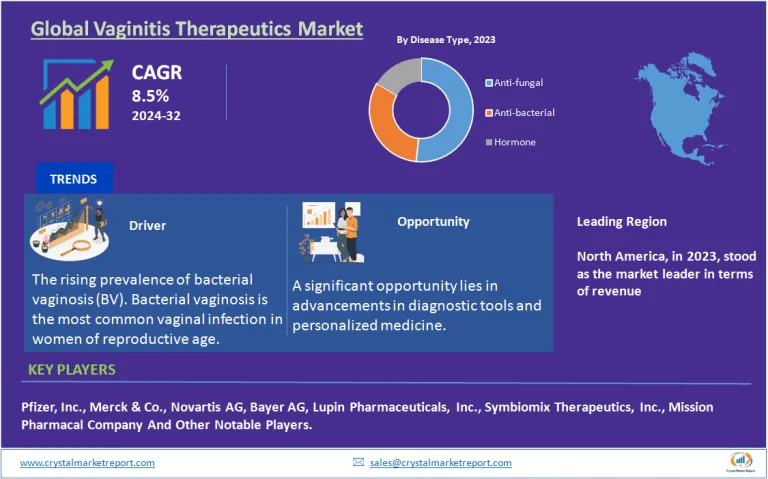Market Overview
In the realm of medical therapeutics, the vaginitis therapeutics market addresses the treatment of an inflammation or infection of the vagina, commonly known as vaginitis. Vaginitis can be caused by bacterial infections, fungal infections, hormonal changes, or allergic reactions. The implications of the condition are more than mere physical discomfort; they stretch to psychological and social realms as well. The vaginitis therapeutics market is estimated to grow at a CAGR of 8.5% from 2024 to 2032.
Vaginitis Therapeutics Market Dynamics
Market Driver: Rising Prevalence of Bacterial Vaginosis
One of the most notable drivers of the vaginitis therapeutics market has been the rising prevalence of bacterial vaginosis (BV). Bacterial vaginosis is the most common vaginal infection in women of reproductive age. A report published in the Journal of Clinical Microbiology highlighted that BV affects approximately 29% of women in the U.S., making it more common than yeast infections. This high prevalence directly correlates with an increased demand for effective treatments. Additionally, a study in the American Journal of Obstetrics & Gynecology linked untreated BV with serious health complications such as preterm birth, making timely and effective treatment crucial.
Opportunity: Advancements in Diagnostics and Personalized Medicine
A significant opportunity lies in advancements in diagnostic tools and personalized medicine. As the Journal of Women's Health pointed out, early and accurate diagnosis can lead to better patient outcomes. New-age diagnostic tools that use genomic and proteomic profiling can identify the exact cause of vaginitis, allowing for targeted treatment. Furthermore, the push towards personalized medicine, as endorsed by institutions like the Mayo Clinic, suggests treatments tailored to an individual's genetic makeup. Such advancements not only increase the efficacy of treatment but also reduce potential side effects.

Restraint: Lack of Awareness and Social Stigma
Despite the advancements, a major restraint in the market is the lack of awareness and the existing social stigma. In many cultures and societies, discussing vaginal health is taboo, which prevents women from seeking timely medical intervention. A publication in Women's Health Issues journal showcased that in certain regions, less than half of the women with symptoms of vaginitis consult a healthcare professional. This reluctance is often tied to societal norms, lack of education, or fear of judgment, leading to an underdiagnosis and undertreatment of the condition.
Challenge: Antimicrobial Resistance in Vaginitis Treatment
A looming challenge that the market faces is the rise of antimicrobial resistance (AMR) in the treatment of vaginitis. Over the years, overuse and misuse of antibiotics have led to the evolution of drug-resistant strains of bacteria causing vaginitis. This was highlighted in a paper in the Clinical Infectious Diseases journal, where strains of bacteria resistant to metronidazole, a commonly prescribed drug for BV, were identified. The rise of such resistant strains poses a challenge as it calls for the development of new drugs and treatment modalities, requiring significant research and financial investments.
Market Segmentation by Disease Type
In 2023, the Anti-bacterial segment dominated the market in revenue terms. The frequent occurrence of bacterial infections like BV contributed significantly to this revenue. The substantial market share was buttressed by the sheer prevalence of bacterial vaginosis as evidenced by clinical reports. Meanwhile, the Anti-fungal segment is expected to showcase the highest CAGR from 2024 to 2032. With the increasing occurrence of fungal infections such as candidiasis, there's a greater demand for antifungal treatments. Hormonal treatments, primarily utilized for atrophic vaginitis caused due to reduced estrogen levels, especially in post-menopausal women, also observed steady growth. However, their growth rate is neither as robust as the anti-bacterial nor the promising trajectory of the anti-fungal.
Market Segmentation by Product
In 2023, Prescription products accounted for the lion's share of the market revenue. The stringent nature of vaginitis, coupled with the potential complications, meant many patients sought direct medical intervention, leading to prescription-based therapeutics. Moreover, the assurance of an accurate diagnosis and a tailored treatment plan contributed to the segment's dominance. In contrast, from 2024 to 2032, the OTC segment is anticipated to record the highest CAGR. This growth is attributed to the rising awareness of vaginitis and the increasing self-diagnostic trend, leading consumers to opt for over-the-counter solutions. The convenience, accessibility, and cost-effectiveness of OTC products will propel their growth in the coming decade.
Market Segmentation by Region
Throughout 2023, North America led the market in revenue terms, attributable to advanced healthcare infrastructure, heightened awareness, and the presence of major market players in the region. However, from 2024 to 2032, the Asia-Pacific region is projected to register the highest CAGR. Factors such as improving healthcare systems, increased expenditure in healthcare, and a burgeoning middle-class population are anticipated to fuel this growth. Furthermore, rising awareness and gradual breaking of societal norms regarding vaginal health in countries like India and China are also poised to boost the market in this region.
Competitive Trends
In the backdrop of the revenue and CAGR trend, competitive trends manifest a fascinating tapestry. In 2023, major players like Pfizer, Inc., Merck & Co., Novartis AG, Bayer AG, Lupin Pharmaceuticals, Inc., Symbiomix Therapeutics, Inc., and Mission Pharmacal Company dominated the vaginitis therapeutics market, leveraging robust R&D investments and widespread distribution networks. Their key strategies encompassed mergers, acquisitions, and the development of innovative therapies. Looking into the crystal ball of 2024 to 2032, these behemoths, along with emerging players, are expected to delve deeper into personalized medicine and genomic diagnostics. The overarching strategy revolves around innovation, patient-centric solutions, and expanding global footprints, particularly in high-growth regions like Asia-Pacific.